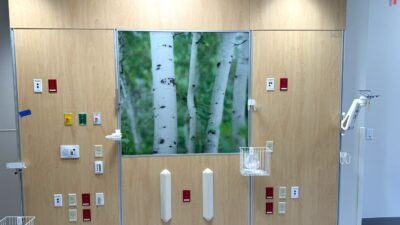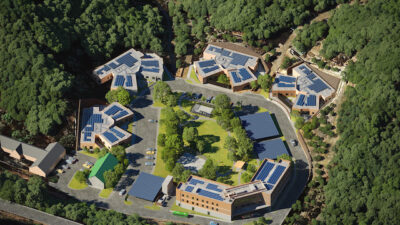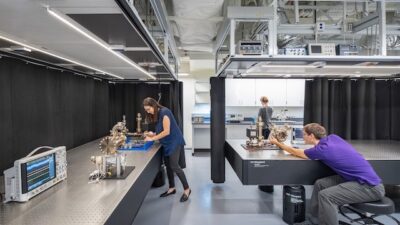Most firms in the business of designing and building health-care facilities would agree that the market continues to be strong. But 40-year industry veteran Robert Levine is more emphatic. "It's the strongest health-care market I've ever seen in my life! There are no soft spots to speak of, geographically," says Levine, vice president of health care for Turner Construction, St.
Most firms in the business of designing and building health-care facilities would agree that the market continues to be strong. But 40-year industry veteran Robert Levine is more emphatic. “It’s the strongest health-care market I’ve ever seen in my life! There are no soft spots to speak of, geographically,” says Levine, vice president of health care for Turner Construction, St. Louis.
And according to David Pope, P.E., senior associate with Heery International, Atlanta, this building activity has been growing, since 1999, at a rate of 10% to 15% per year.
What’s behind the boom? Levine suggests a number of reasons, including:
-
83 million baby boomers approaching 60.
-
Rapidly developing medical technology.
-
Growing popularity of replacement hospitals on greenfield sites.
-
Hospital consolidation.
-
A good financial reimbursement environment.
-
The aging infrastructure of existing facilities.
“I think we’re rebuilding the nation’s entire hospital infrastructure,” says Levine.
But looking beyond the factors fueling this phenomenal growth market, what are some of the major design trends in health-care construction today? Promoting sustainable design, dealing with existing infrastructure and making use of fully integrated equipment packages are just a few of the current trends.
Green is growing
It’s not quite there yet, but sustainable design is creeping onto the scene. While some health-care facility owners have shown an interest, it has yet to become as popular for health care as for other building market sectors.
“Sustainable design [for health-care facilities] is still in its early stages. People need to be educated, and that education is just now getting out there,” explains Michael Sheerin, P.E., health care division director, TLC Engineering for Architecture, Orlando. “It’s a challenge for hospitals. They are so energy-intensive.”
In addition, Pope points out, hospital construction in the past often involved small renovations. But up until about two years ago, the U.S. Green Building Council’s LEED accreditation program focused primarily on new construction. It wasn’t until mid-2002 that the LEED for Existing Buildings (LEED-EB) pilot program began, and not until last year that the first LEED-EB building was certified.
In any case, Warren Wertz, P.E., a vice president with Hayes Seay Mattern & Mattern, Roanoke, Va., explains, “What we’re finding is that hospitals appear to have an interest in sustainable design but not to the extent that they’re interested in [pursuing LEED] accreditation, because meeting those requirements means adding cost to construction.”
However, Al Borden, LC, IALD, ELDA, president of The Lighting Practice, Philadelphia, points out that in his experience, even if hospitals don’t attain actual LEED accreditation, they do their best to get as close as possible.
“For virtually every [health-care] project we’re working on, it’s been a discussion item to incorporate LEED-type elements,” concurs Brian Braaksma, P.E., a partner with Korda/ Nemeth Engineering, Columbus, Ohio.
Taking a look at the market, only one LEED-certified hospital exists at the present time—Boulder Community Foothills Hospital, Boulder, Colo.—but 20 other hospitals are now in the process of trying to attain accreditation. In addition, the USGBC is currently supporting the creation of a LEED Application Guide for Healthcare with the goal of helping health-care project teams qualify for LEED credits.
In a nutshell, the health-care community must first undergo a change of philosophy toward sustainable design. And in the opinion of Steven M. Dailey, P.E., and Stephen Milz, P.E., associates with HarleyEllis, Southfield, Mich., once the trend starts gaining momentum, it will become more and more in vogue as hospitals attempt to realize greater energy efficiencies. Further, as more contractors become involved in sustainable construction, the costs will come down, and it will become more popular with health-care facility administrators.
In fact, Turner’s Levine is betting on such a trend. He recently added a LEED-accredited sustainable design specialist to his staff.
Battling the legacy
While qualifying for LEED credits can challenge budget-conscious hospitals, dealing with old legacy building systems and infrastructure poses yet another set of challenges.
“Working with existing buildings built 20, 30 or 40 years ago is one of the hardest things we do,” says Kevin M. Pope, P.E., associate vice president in the Milwaukee office of Hammel Green & Abrahamson. With a tinge of sarcasm, TLC’s Sheerin agrees: “That’s our workday fun—dealing with existing systems,” he says.
Sheerin’s TLC associate Tom Munson, RCDD, division director, communications and technology, explains, “We have to go in and look at the capacity of what they have to see if we can expand it. In a lot of cases, we’re finding we have to completely uproot it. This is often a big surprise to the client and can be very painful.”
“Hospitals are under pressure to allocate capital wisely,” adds Sheerin, “and it’s painful for them to talk about infrastructure changes. We’ve had a couple of projects where the infrastructure cost was almost as much as the job.”
Offering a similar observation, Kevin Pope points out, “I’ve yet to see the construction estimate come in under budget.” And in many cases, changing code requirements, limited load capabilities and stricter ventilation rules and infection control requirements rule out the possibility of beefing up older systems.
“We’re finding it harder and harder to reutilize existing equipment,” says Dailey.
“And some of the electrical equipment isn’t even being manufactured anymore, so we’ve got to get rid of this [older] junk,” adds Dailey’s associate Milz.
Due to the frequency with which these issues come up, Dailey explains, project teams are spending more time with facility personnel to learn about the history of existing systems in order to determine how to best proceed.
“For almost every project, we end up doing some level of facility assessment prior to getting into the design work because we need to have that information up front,” states Sheerin.
Future fit-out
While dealing with legacy systems of the past, designers must also look to the future to keep up with the lightning pace of advancing medical technology and the changing building system requirements associated with it.
Outlining the process of building your average 150-bed hospital, Levine explains that it takes approximately a year to a year and a half to design at $200 to $250 per sq. ft., plus another 40% for equipment. “By the time it’s built, it will be four years. You’re at $100 million just like that, but you need state-of-the art for now—not then,” he says.
In short, the technology and equipment are changing faster than project teams can build buildings, says HSMM’s Wertz. To plan efficiently, it’s crucial for the A/E, the owner, the equipment manufacturer and the equipment supplier to work closely together.
One approach that TLC has employed is called on-time technology. “On our documents we will carve out a space for a piece of equipment in a specific area, but we try to delay purchasing the equipment,” explains Munson. “Traditionally, you get more bang for your buck because the package gets smaller and uses less energy.”
Designers are also specifying more robust infrastructures with larger pipe sizes and electrical capacities to accommodate future fit-outs.
Yet another approach is the universal utilities concept where facilities are designed with the capacity to hook up to both gas and electric. Although it’s more expensive and some hospital owners opt to go without it, Levine states, “We never encourage a client to do anything but that.”
“We try to masterplan utilities more because we know there is going to be an increase in the need for electricity, heating and cooling,” explains David Pope. “Frequently, hospitals outgrow their wildest expectations.”
Similarly, Turner advises clients to build universal examination rooms and patient rooms. “These bigger rooms are a little bit more expensive, but the flexibility is worth it,” he adds.
The HarleyEllis approach is to take into account vertical expansion and associated stress loads in their specifications. They also design for periodically spaced wet column risers, sanitary and vent risers for future hook-ups, ceiling booms to support significant medical equipment loads and a looped medical gas system running through the floor.
In general, health-care facility designers must be prepared for a few revisions and associated adjustments in the exhaust, supply air and electrical loads before the final equipment is purchased and installed. For this reason, Hammel Green & Abrahamson frequently works with a medical equipment consultant.
Digital replacing hard copy
Another innovation that is rapidly transforming health care is the transition from film and hard copy medical records to electronic (see “Totally Digital,” p. 32). Hospitals don’t need as much room for hard copy storage, but they are requiring greater data storage and communications capacity, which means robust servers, racks, cabling trays and support hangars.
Hospitals now need to be wired to send this electronic patient information around the building, says Wertz. And in some cases, owners want these networks to be completely separate from IT. “You have to build in more space [for this] and deal with the heat loads from all this equipment,” says Braaksma. In addition, more UPS are being specified as these data systems are becoming more and more volatile with so much medical data in storage.
Do it all
Another interesting trend in health-care construction is large manufacturers, such as Siemens, Phillips and GE, offering fully integrated equipment packages and services, including controls, HVAC, telecom, medical equipment and financing. Similarly, companies like Johnson Controls and Honeywell are offering entire CSI MasterFormat Division 17 packages. “They’re saying, ‘Look, we can do it all,'” says Milz.
While hospital owners will save time and money by dealing with one supplier, it can be a tough sell because traditionally, directors of the different departments within a hospital decide which equipment to purchase, according to Sheerin, so the manufacturer is typically dealing with departmental, clinical and facility-level decisions.
“CEOs give these [department heads] a lot of latitude to keep them happy. They want to keep them around, as they bring in a lot of business,” Sheerin explains.
Levine concurs that hospitals often don’t want to be locked into one manufacturer.
In any case, once a manufacturer gets in the door, Munson claims, the project could run very smoothly or there could be big problems. “We’ve seen it work, and we’ve seen it not work. It depends on what [the manufacturers] bring to the table. Sometimes they really don’t have the staff on board, and they hire subcontractors to come in,” he says. “They may not have a good grasp on it, and the project can turn into a disaster.”
“It’s a phenomenon that’s occurring,” says Levine, “but I’m not seeing a lot of it, and I don’t see it becoming a panacea.”
Boom, boom, boom
As for the future, consultants are betting on continued growth. “In the last three years, we’ve done a ton of health care and we’re still doing it,” states Kevin Pope.
HSMM’s Wertz agrees. “What we’re seeing is going to continue for the next several years,” he says.
Evidence for Evidence-Based Design
Currently being promoted by the Center for Health Systems and Design, among others, evidence-based design directly links health-care facility design with the healing process.
“Evidence-based design, where the environment aids healing, is a phenomenon that’s occurring,” states Robert Levine, vice president of health care for Turner Construction Company.
For example, installing grab bars and wider bathroom doors and reducing glare can help prevent patient falls. And for nosocomial infections, more hand-washing stations and HEPA air-filtration systems are recommended. In fact, one recent change to NFPA 101, the Life Safety Code, has made it possible to install alcohol-based hand sanitizers in hospital corridors. (For more information, see “Sanitizing Hands” by going to www.csemag.com and clicking the red Fire, Security and Life Safety button.)
Another example is lighting design. With stepped lighting, nurses can increase lighting for reading and then step it down for patient comfort. Nurses are also kept happy with aesthetically lit and comfortably controlled workstations.
Continuing Fitness of Health-Care Market
A recent survey commissioned by New York-based Turner Construction reveals that 69% of 200 senior health-care executives polled are “very” or “extremely” likely to undertake a major capital expansion project in the next three years.
“Obsolete facilities, combined with a lack of capacity due to a growing population of baby boomers, have created huge demand for new and enhanced buildings,” says Robert Levine, Turner’s vice president of health care. “We believe that this trend will continue for years to come.”
The survey also found that 58% are currently outsourcing design and construction services.
As far as future plans for outsourcing, 64% of those who are currently outsourcing indicated intentions to continue doing so.
However, for those who are not contracting out at this time, only 4% of these health-care executives foresee outsourcing a year from now.
Another trend is that more and more hospital facilities are becoming outdated. Turner has begun marketing a novel redevelopment concept to take advantage of this.
The idea, says Turner’s vice president of health care Robert Levine, is to enable an adaptive re-use of existing hospital campuses by offering 25% of the campus to agencies such as the Dept. of Sanitation or the Dept. of Education, building up 25% of the property for commercial space, another 25% to be allocated for start-up companies and the remaining 25% to be used as outpatient and rehabilitation space. In addition, the developer redoes the campus landscape.



